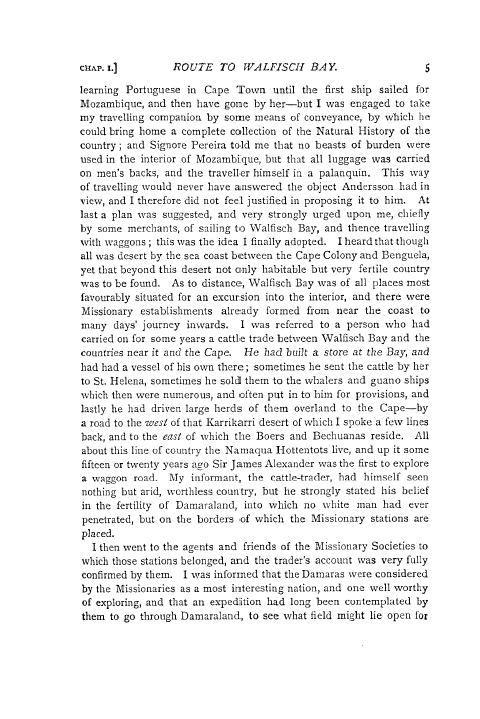CHAP. 1.1 ROUTE TO WALrISCII BAY. 5
learning Portuguese in Cape Town until the first ship sailed for Mozambique, and then have gone by her-but I was engaged to take my travelling companion by some means of conveyance, by which he could bring home a complete collection of the Natural History of the country ; and Signore Pereira told me that no beasts of burden were used in the interior of Mozambique, but that all luggage was carried on men's backs, and the traveller himself in a palanquin. This way of travelling would never have answered the object Andersson had in view, and I therefore did not feel justified in proposing it to him. At last a plan was suggested, and very strongly urged upon me, chiefly by some merchants, of sailing to Walfisch Bay, and thence travelling with waggons ; this was the idea I finally adopted. I heard that though all was desert by the sea coast between the Cape Colony and Benguela, yet that beyond this desert not only habitable but very fertile country was to be found. As to distance, Walfisch Bay was of all places most favourably situated for an excursion into the interior, and there were Missionary establishments already formed from near the coast to many days' journey inwards. I was referred to a person who had carried on for some years a cattle trade between Walfisch Bay and the countries near it and the Cape. He had built a store at the Bay, and had had a vessel of his own there ; sometimes he sent the cattle by her to St. Helena, sometimes he sold them to the whalers and guano ships which then were numerous, and often put in to him for provisions, and lastly he had driven large herds of them overland to the Cape-by a road to the west of that Karrikarri desert of which I spoke a few lines back, and to the east of which the Boers and Bechuanas reside. All about this line of country the Namaqua Hottentots live, and up it some fifteen or twenty years ago Sir James Alexander was the first to explore a waggon road. My informant, the cattle-trader, had himself seen nothing but arid, worthless country, but he strongly stated his belief in the fertility of Damaraland, into which no white man had ever penetrated, but on the borders of which the Missionary stations are placed.
I then went to the agents and friends of the Missionary Societies to which those stations belonged, and the trader's account was very fully confirmed by them. I was informed that the Damaras were considered by the Missionaries as a most interesting nation, and one well worthy of exploring, and that an expedition had long been contemplated by them to go through Damaraland, to see what field might lie open for

